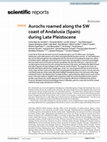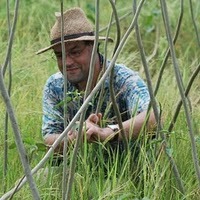Papers by Geraldine Finlayson
Quaternary International, 2008
Quaternary Science Reviews
Quaternary Science Reviews

Quaternary Science Reviews
A Late Pleistocene surface full of tracks and trackways (named 'Matalascañas Trampled Surface') h... more A Late Pleistocene surface full of tracks and trackways (named 'Matalascañas Trampled Surface') has been exposed at the base of the 'El Asperillo' cliff (Doñana National Park, Matalascañas, Huelva, southwestern Spain) as a result of recent storms. This surface has been identified as the bottom of the unit AU1, according to the local stratigraphic section, and originated during the marine stage MIS-5 (~106 ± 19 kyr). This trampled surface records exceptional tracks and trackways of different terrestrial vertebrates. In particular, three morphotypes of tracks ascribed to Artiodactyla (the auroch Bos primigenius? the red deer Cervus elaphus and wild boar Sus scrofa), one to Elephantidae (Palaeoloxodon antiquus), one of Canidae (Canis lupus), and three to waterbirds (geese, Anserinae, and waders, Charadrii) have been identified. This ichnoassociation is characteristic of a shorebird ichnofacies. We interpret this trampled surface to have been related to puddled areas of shallow waters in an inter-dune position, similar to present day examples in the Doñana National Park.
Quaternary International, 2008
Geotemas ( Madrid ), 2016
Review of Palaeobotany and Palynology, 2021

Review of Palaeobotany and Palynology, 2021
Abstract The Donana area in southern Iberia is one of the most renowned protected areas of Europe... more Abstract The Donana area in southern Iberia is one of the most renowned protected areas of Europe, mostly due to the diversity and value of its wetland ecosystems. The large biogeographical significance of this territory and the outstanding availability of sedimentary archives have made this region a hotspot of paleobotanical research in the Iberian Peninsula. Specifically, the organic deposits on El Asperillo Cliff have been studied during the past few decades from the geomorphological and paleobotanical (pollen, macrofossils) points of view. However, large uncertainties remain concerning the chronology of certain sections of the exposed profile and the paleobotanical potential of this site has not been fully exploited yet. In this study, we revisited El Asperillo with the aims of completing the paleobotanical record and refining the chronology of this site. The age of the studied deposits ranges from ca. 22,000 to 30,900 cal. yr BP according to the radiocarbon dates obtained, thus embracing the particularly cold and dry Heinrich Event 2 and the Last Glacial Maximum. Our palynological results allow inferring the presence of a coastal marshland system. Additionally, the new pollen records highlight the relevance and diversity of pines (Pinus nigra-sylvestris type, P. pinaster, P. halepensis-pinea type) in the Late Pleistocene landscape of Donana, reinforcing the native status of pines. Last but not least, the results stress the persistence of a highly diverse woody flora in Donana during the harshest periods of the last glacial cycle, highlighting the importance of this enclave in postglacial vegetation recolonization of the Iberian Peninsula.
ABSTRACT The limestone Rock of Gibraltar offers a complete register of marine erosion, at differe... more ABSTRACT The limestone Rock of Gibraltar offers a complete register of marine erosion, at different scales, that include periods of tectonic uplifting lasting for tens or hundreds of thousands of years, and climatic and eustatic events lasting thousands or tens of thousand years.
ABSTRACT The main morphological erosion record in the limestone rocky shore of Gibraltar is linke... more ABSTRACT The main morphological erosion record in the limestone rocky shore of Gibraltar is linked with the Last Interglacial period (OIS 5e). A pervasive notch at +5 m runs along the coastal cliffs. The composite assemblage dominated by the ichnotaxons Gastrochaenolites and Entobia linked to these forms records the overlaying of successive ichnocoenoses during the beginning of transgressive event.
Información del artículo La fauna de mamíferos solutrense de Gorham's Cave, Gibraltar.
actualidad una amplia rampa arenosa, de unos 35º de pendiente, formada por sets de arenas eólicas... more actualidad una amplia rampa arenosa, de unos 35º de pendiente, formada por sets de arenas eólicas (Catalan Sands Formation) que, procedentes de una antigua llanura costera entre-20 m y los acantilados hasta +6 m, se apilaron y ascendieron por la ladera rocosa hasta casi 300 m de altitud (Ibex Cave). La datación por OSL de los tramos basales y la edad del relleno final de las cuevas asociadas, nos demuestran que este evento eólico se inició inmediatamente antes del Último Máximo Interglacial (OIS 6-5) y se prolongó hasta el final del OIS 3 (30 ka). Bajo este registro dunar existe un gran deslizamiento rocoso, doblemente escalonado, y brechas de ladera, que facilitaron la acumulación al pie del acantilado de hasta 60 m de espesor de arenas silíceas y su posterior ascenso en rampa.
Almoraima Revista De Estudios Campogibraltarenos, 2001
Post-Medieval Archaeology, 2019
In 2014, during construction work at the ex-Civil Hospital in Gibraltar, excavations led by the G... more In 2014, during construction work at the ex-Civil Hospital in Gibraltar, excavations led by the Gibraltar Museum revealed a major, previously unknown burial ground containing more than 200 skeletons. We present the historical, archaeological and radiometric dating evidence from the site alongside the results of initial osteological analyses. The data indicate that the burials pertain to an earlier 16 th century Spanish hospice, and therefore stand to offer new insights into the functioning of this early modern hospital and the health and movements of people at a time of incipient globalisation.

Scientific Reports
In the Iberian Peninsula the fossil record of artiodactyls spans over 53 million years. During th... more In the Iberian Peninsula the fossil record of artiodactyls spans over 53 million years. During the Pleistocene, wild cattle species such as Bison and especially Bos became common. In Late Pleistocene, the aurochs (Bos primigenius) was widespread and the only bovine living along the large river valleys of southern Iberia. Although commonly found in fossil sites and especially in cave bone assemblages, the trace fossil record of aurochs was known worldwide only from the Holocene. Large bovine and roe deer/caprine tracks were found in at least five horizons of the early Late Pleistocene (MIS 5) beach and eolian deposits of Cape Trafalgar (Cadiz Province, South of Spain). The large bovine tracks are formally described as Bovinichnus uripeda igen. et isp. nov. and compared with the record of aurochs tracks, large red deer tracks and steppe bison biogeographical distribution in Iberia. Aurochs were the most likely producers of the newly described Trafalgar Trampled Surface (TTS) and some ...
PLOS ONE
We tracked pallid swifts (Apus pallidus brehmorum) from a single breeding colony in Gibraltar ove... more We tracked pallid swifts (Apus pallidus brehmorum) from a single breeding colony in Gibraltar over two years. Our results show movement of birds between specific regions within the non-breeding geographical area at specific times of the year. The tracking of a single individual showed remarkable fidelity to the areas visited between years. Furthermore, two pallid swifts tracked over the entire eight-month non-breeding period, while in Africa, gave no indication of coming to land, supporting previous findings of an airborne existence in swifts outside the breeding season. In addition, the crossing of the Sahara Desert to and from breeding grounds is remarkably fast, with one individual crossing it in just over a day. We discuss our findings in the context of bird migration evolutionary strategies.
La ocupación durante la Prehistoria Reciente de las cavidades gibraltareñas es un tema que debido... more La ocupación durante la Prehistoria Reciente de las cavidades gibraltareñas es un tema que debido a diversas razones ha pasado inadvertido a la historiografía regional; Excavaciones antiguas seguidas de años con intervenciones no sistemáticas han deparado una pérdida de importante información hasta la llegada del Gibraltar Caves Project. Con este trabajo pretendemos paliar, en la medida de lo posible, este vacío de estudios, presentando las cavidades que con fines sepulcrales proponemos, se ocuparon en Gibraltar durante la Prehistoria Reciente.

The drainage of the lake of La Janda (Cadiz, Spain), Spain's largest lake, commenced at the b... more The drainage of the lake of La Janda (Cadiz, Spain), Spain's largest lake, commenced at the beginning of the nineteenth century and the process was virtually complete by 1962. Its drainage signified the loss of one of the most important wetlands in the Palaearctic. There is currently a renewed interest in La Janda and the possibility of its regeneration is under study by the Consejeria de Medio Ambiente of the Junta de Andalucia and the University of Cordoba. The purpose of this paper is to summarise the value of La Janda prior to its drainage through the results of a multidisciplinary study and to propose an integrative model for its regeneration which takes into account not only its geological and biological potential but also its historical and archaeological values. The study brings together data from historical and archaeological research with that gathered in the field by geologists and biologists. The model, which includes the physical and biotic processes operating acros...










Uploads
Papers by Geraldine Finlayson